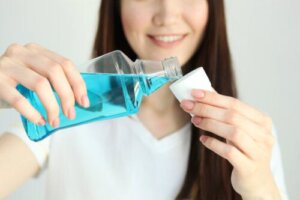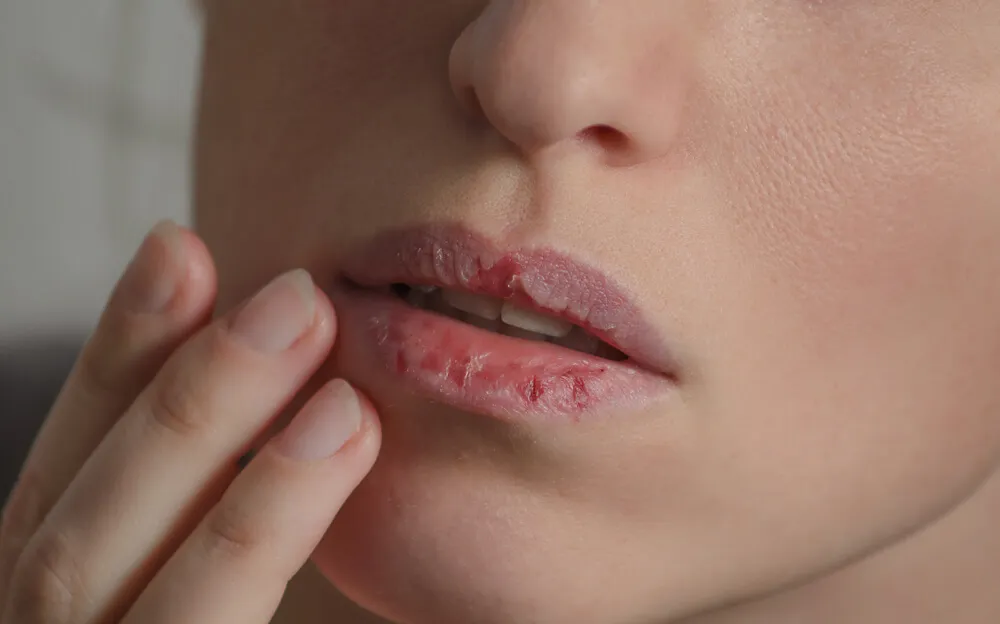Mouthwash: Types, Characteristics, and Side Effects


Written and verified by the dentist Vanesa Evangelina Buffa
The use of mouthwash as part of an oral hygiene routine is common in many people. Finishing brushing by swishing with these products gives the sensation of a cleaner and fresher mouth.
In any case, you should know that there’s a wide variety of these products on the market. Even your dentist may indicate the use of a specific mouthwash to prevent or treat an oral problem.
Although these products are safe if used correctly, there’s still the possibility of some side effects. Read on to learn everything you need to know about the different types of mouthwash here!
What is mouthwash?
Mouthwash, also called mouth or oral rinse, is a liquid solution that is swished or gargled for a period of time in the mouth to clean oral structures. Bathing the teeth, gums, tongue, and other mucous membranes with this product helps promote oral health.
Mouthwashes contribute to oral hygiene by promoting the elimination of germs and controlling bacterial plaque. In addition, they leave behind fresh breath, moisturize oral tissues, and reduce mouth discomfort.
The ingredients used in mouthwashes vary among commercial brands and give them different characteristics. Thus, rinses can be found to prevent cavities, treat gingivitis, or even whiten the teeth.
The importance of mouthwash
Mouthwash is a complement to oral hygiene to make it more complete and effective. In no case does it replace tooth brushing and flossing, but rather reinforces them.
Since this is a liquid that moves in the mouth, mouthwash reaches areas that are difficult to access, where the bristles of the toothbrush and floss can’t reach. Thus, thanks to its action, it reduces the proliferation of microorganisms and the formation and accumulation of bacterial plaque.
This helps to prevent several dental diseases in which oral bacteria are involved, such as caries and gingivitis. It also freshens the breath and can improve some cases of halitosis.
Types of mouthwash
Most oral rinses help to reduce the number of germs in the mouth and prevent diseases of the oral cavity. However, there are also many types of mouthwash that are used precisely in specific situations.
It’s possible to find a great offer and variety of these products on the market that are usually over-the-counter. Knowing the differences and characteristics of each mouthwash can be of great help when looking for the right one.
When choosing the right one, it’s best to consult a dentist to choose the mouthwash that best suits the individual needs of your mouth. In this article, we’ll take a look at the different types of oral rinses and when it’s recommended to use them.

Common mouthwash
This is the most basic and common mouthwash on the market, as its active ingredients are similar to those of the most common kinds of toothpaste. This liquid eliminates bacteria and food debris from the mouth, leaving a fresh breath sensation.
Due to its fluoride content, it provides slight protection against cavities. They are available in different flavors and some contain alcohol.
Anti-plaque or antiseptic mouthwash
The active ingredients contained in this type of mouthwash make it very effective in reducing bacterial plaque in the mouth. The antiseptic chlorhexidine digluconate is often used, but it’s sometimes combined with other ingredients such as phenols, povidone-iodine, metallic salts, or essential oils.
They are the types of mouthwash that are ideal for the treatment of gingivitis and periodontitis. They can also be useful after implant placement or other oral surgery, as they reduce the risk of infection and promote tissue healing.
In cases of canker sores and mouth ulcers, an antiseptic mouthwash can reduce discomfort and speed healing.
Fluoride mouthwash
This is a type of mouthwash that contains a higher concentration of fluoride than those that are commonly used. For this reason, it’s able to protect the tooth enamel, prevent cavities, and even reverse the early stages of the disease.
These types of fluoride mouthwash are useful for adults and children who are at high risk of developing cavities. Dentists should be the ones to prescribe this type of mouthwash and indicate the correct way to use them. The professional should also specify the frequency and time of use of the product.
Mouthwashes for dry mouth
Patients suffering from xerostomia or dry mouth need to use a mouthwash capable of lubricating their oral tissues. In addition, this type of product reduces the sensation of dry mouth and prevents problems associated with oral dryness, such as plaque build-up and oral infections.
Most of these products combine minerals, fluoride, and vitamin E.
We think you may also enjoy reading this article: 9 Natural and Effective Tips for Taking Care of Your Teeth
Mouthwashes for specific uses
There are mouthwashes that have specific functions and are indicated in particular situations:
- Pre-surgical mouthwash: Your dentist may recommend the use of a mouthwash with hexetidine or chlorhexidine before surgery, especially before periodontal surgery. These ingredients with antiseptic, antibacterial, and antifungal action decrease the risk of complications after surgery.
- Mouthwash for orthodontic patients: This is a type of mouthwash that improves dental hygiene and gives extra protection to patients wearing braces.
- Mouthwash for dentures: This is an alcohol-free mouthwash that strengthens the gums and mucous membranes of patients wearing dentures.
- Tooth whitening reinforcement mouthwash: Your dentist may indicate the use of a mouthwash with low doses of lightening peroxides after a tooth whitening treatment. Using the product from time to time will prolong the results obtained.
- Rinses for sensitivity: For people who experience tooth sensitivity, the use of a mouthwash containing potassium nitrate may be helpful. However, it’s not recommended to use it for more than 2 or 3 weeks.
Characteristics of mouthwashes
A mouthwash is characterized as a liquid solution capable of removing food debris, germs, and bacterial plaque accumulated in the mouth. The addition of specific ingredients allows for a wide variety to treat and solve specific problems.
Another characteristic aspect is that they’re easy to use, so they can be used by both adults and children who know how to spit. However, their use is not recommended for children under 6 years of age.
It’s also not advisable to use these products in people who have a compromised immune system or who are undergoing chemotherapy. Although its handling is simple, it’s always advisable to read the manufacturer’s instructions.
In general, unless otherwise indicated by the dentist, its use is recommended after brushing and flossing. Place a measure of the product in the cap provided for this purpose and put it in the mouth.
The liquid is kept inside the oral cavity making movements that allow the liquid to reach all the structures of the mouth. After a minute or so, spit it out and do not rinse again or eat or drink for at least half an hour after use.
With these simple steps. it’s possible to protect the oral cavity, reduce bacterial plaque, and get fresh breath.
Like this article? You may also like to read: Seven Home Remedies for Removing Plaque From Your Teeth
Possible side effects of mouthwash
Some components of mouthwashes can give rise to these side effects:
- Mucosal irritation: This is especially the case of the types of mouthwash containing alcohol or sodium lauryl sulfate (SLS), which can irritate oral mucous membranes. They should be avoided if there are non-healing lesions or canker sores.
- Tooth stains: Some antiseptics contained in mouthwashes can stain teeth and mucous membranes if used for a prolonged period of time. That’s why it’s important to follow the dentist’s instructions to avoid this undesirable effect, especially when using a mouthwash containing chlorhexidine, hexetidines, or peroxides.
- Stomach problems: Swallowing small amounts of mouthwash may cause heartburn, colic, or diarrhea.
- Allergies: Ingredients in mouthwashes may cause allergic reactions in some people. This causes swelling of the lips and gums, burning, rashes, or difficulty breathing. In such cases, it’s essential to discontinue use and consult a physician to treat the allergic condition. If there is a history of intolerance to xylitol, flomentol, or SLS, labels should be checked to avoid products containing them.
- Oral dryness: Although several types of mouthwash are available to improve dry mouth conditions, those containing alcohol may worsen the situation.
- Burning or pain when used: Some people report a tingling, burning, or painful sensation when mouthwashes containing alcohol are swished.
- Eliminating the healthy oral microbiome: Using a very strong antiseptic mouthwash on a frequent basis can eliminate beneficial bacteria in the mouth.
- Increased cancer risk: Some synthetic ingredients used in the manufacture of certain oral rinses have been linked to increased cancer risk, such as triclosan. Their use should be limited to situations deemed appropriate by the dentist.

Signs that indicate overuse of mouthwash
The use of a mouthwash prescribed by the dentist should be based on the dentist’s instructions. In the case of over-the-counter mouthwashes, it’s recommended not to exceed one or two times a day.
However, there are people who like the feeling of a clean mouth and fresh breath that these products provide and use them more than several times a day. Excessive use of mouthwash can lead to various side effects:
- Bleeding gums when using mouthwash
- Persistent aphthous ulcers
- Dry mouth
- Pain or sensitivity in the mouth after using the product or when brushing the teeth
- Stains on the teeth
An ally in mouth care when used responsibly
Mouthwash is a great ally when it comes to oral health care. It’s a complement to brushing and flossing that helps to reach places that bristles and floss cannot reach.
However, it must be used responsibly. Consulting your dentist about the best product for the needs of your own mouth and using it following the professional’s recommendations will help prevent complications and ensure you make the most out of this product.
All cited sources were thoroughly reviewed by our team to ensure their quality, reliability, currency, and validity. The bibliography of this article was considered reliable and of academic or scientific accuracy.
- Soria-Hernández, M. A., Molina, N., & Rodríguez, R. (2008). Hábitos de higiene bucal y su influencia sobre la frecuencia de caries dental. Acta pediátrica de México, 29(1), 21-24.
- Leyva Bahena, S., Badillo Alvíter, G., Reyes Ríos, R., & Campos Hernández, E. (2016). Efectividad antimicrobiana de cuatro enjuagues bucales. Tlamati Sabiduría.
- Alemán, L. F. J., Guerrero, J. C. H., Farfán, M. D. J., & Salgado, A. L. (2011). Determinación a corto plazo de la efectividad y sustentabilidad de tres enjuagues bucales comerciales ante la halitosis. Revista odontológica mexicana, 15(4), 219-223.
- Bascones, A., & Morante, S. (2006). Antisépticos orales: Revisión de la literatura y perspectiva actual. Avances en periodoncia e implantología oral, 18(1), 21-29.
- Pacheco, A. E. F., Cabrera, S. D. G., & Sime, C. L. D. C. H. (2019). ANTISÉPTICOS ORALES: CLORHEXIDINA, FLÚOR Y TRICLOSÁN. Salud & Vida Sipanense, 6(2), 4-14.
- Feldmuth Gonzales, H. J. (2021). Actividad antibacteriana del aceite esencial de eucaliptus globulus en comparación con gluconato de clorhexidina al 0.12% en la inhibición de porphyromona gingivalis in vitro.
- Loaiza Aguilar, J. G. (2021). Eficacia de enjuagues bucales de libre venta con peróxido de hidrógeno para el aclaramiento dental.
- Roncal-Espinoza, R. J., & Tay-Chu-Jon, L. Y. (2018). Aclaramiento dental con enjuagues de libre venta que contienen peróxido de hidrógeno. International journal of odontostomatology, 12(2), 121-124.
- Cantos, V., & Steward, I. (2021). Diferencias clínicas en el tratamiento periodontal con y sin el uso de clorhexidina. Revisión sistemática.
- López, M. D. L. C. T., Álvarez, M. D., & Morales, A. A. (2017). La clorhexidina, bases estructurales y aplicaciones en; la estomatología. Gaceta Médica Espirituana, 11(1), 8.
- Shrestha, P., Zhang, Y., Chen, W. J., & Wong, T. Y. (2020). Triclosan: antimicrobial mechanisms, antibiotics interactions, clinical applications, and human health. Journal of Environmental Science and Health, Part C, 38(3), 245-268.
- Sánchez-Bernal, J., Conejero, C., & Conejero, R. (2020). Aftosis oral recidivante. Actas Dermo-Sifiliográficas, 111(6), 471-480.
This text is provided for informational purposes only and does not replace consultation with a professional. If in doubt, consult your specialist.








